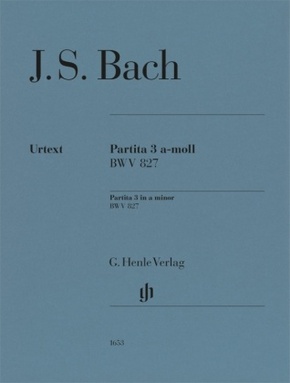Johann Sebastian Bach - Partita Nr. 3 a-moll BWV 827 - Besetzung: Klavier zu zwei Händen
| Verlag | Henle |
| Auflage | 2023 |
| Seiten | 19 |
| Format | 9,7 x 0,2 x 31,6 cm |
| Gewicht | 112 g |
| Reihe | G. Henle Urtext-Ausgabe |
| ISBN-13 | 9790201816531 |
| Bestell-Nr | 96322438BA |
Bei Bachs sechs Klavierpartiten handelt sich um die vermutlich berühmteste und anspruchsvollste Suitensammlung der Musikgeschichte. Bach hat um das Schwergewicht seines Zyklus gewusst, denn er ließ die in Leipzig zwischen 1726 und 1730 entstandenen vielsätzigen Partiten zunächst in Einzelheften im Druck erscheinen, gekrönt 1731 von einem Sammelband mit der stolzen Opuszahl "1". Der G. Henle Verlag legt dieses Gipfelwerk in einer revidierten Urtextedition vor, die neben den Originalausgaben auch handschriftliche Quellen zu Rate zieht und außerdem die zahlreichen Eintragungen der Korrekturexemplare aus Bachs Umfeld ausführlich dokumentiert.
Ganz im Einklang mit dem Bach'schen Vorbild ist die Partita 3 a-moll außer im Sammelband auch in einer handlichen und günstigen Einzelausgabe erhältlich - ideal für den fortgeschrittenen Unterricht und das Selbststudium.
Der hilfreiche Fingersatz des Pianisten William Youn zeichnet sich durch besondere Ergonomie aus und spürt den Sinn- und Phrasierungseinheiten der Musik Bachs sensibel nach.
Interessante Abweichungen der verschiedenen Quellen sind leicht zugänglich in Fußnoten oder geklammert direkt im Notentext wiedergegeben.
Als Bonus enthält die Ausgabe zusätzlich eine spätere Fassung der Gigue, die zahlreiche Tonhöhenänderungen gegenüber der ersten Fassung aufweist.
Inhaltsverzeichnis:
Partita 3 a-moll BWV 827
Bach's Six Partitas form what is presumably the most famous and challenging collection of suites in music history. Bach was aware of the weightiness of his cycle as he initially had these multi-movement partitas, composed in Leipzig between 1726 and 1730, published in individual editions. This culminated in their publication in an anthology that proudly sports the opus number "1" in 1731. Their diversity of forms knows no bounds and the musical texture is infused with the most ingenious counterpoint, but at the same time performers will not miss out on the enjoyment of virtuosic playing in any way. G. Henle Publishers presents this magnum opus in a revised Urtext edition that consults the original editions as well as autograph sources while also extensively documenting the numerous entries in correction copies from Bach's circle.
In keeping with Bach's model, the 3rd Partita, in a minor, is available both in the collective volume and in a handy, inexpensive separate edition tha t is ideal for advanced learners and for self-study.
The helpful fingerings by pianist William Youn are notable for their particular ergonomics, and carefully follow the phrasing and sense of Bach's music.
Interesting deviations in the different sources are made easily accessible in footnotes or in square brackets in the musical text itself.
As a bonus, this edition also contains a later version of the Gigue that has numerous pitch changes compared to the first version.

